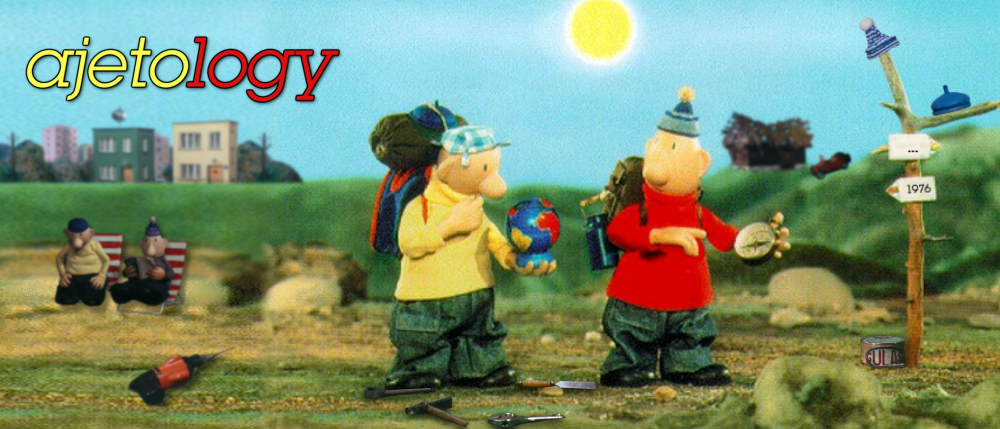On Sunday, October 23, I got to chance to see … a je to! live, in a movie theatre. Six episodes were shown as part of the 15th Central and Eastern European Film Festival, CinEast for short, in the city of Luxembourg, where I currently live. The venue was Cinémathèque Luxembourg, a vintage cinema in the centre of the city that hosts movie lovers of all ages.
There were two showings of this program (at 15.00 and at 16.30) and I got to see the later one, bringing along a friend. The event was kicked off with a short presentation of the series aimed at children. The humor in the series was linked to the silent comedies of Chaplin and Keaton.
It was amusing and flattering to a point to see that the people who made the presentation obviously found some pictures for it on this blog…
The six episodes shown were, in order, Gramofón, Maľovanie, Obraz, Sťahovanie, Dážď and Búdka. 53 minutes might seem short for an adult viewer, but it is probably just about the right time to keep the kids' attention. The episodes were presented as is, without any cuts, and with an applause after every ending credits sequence started to roll out.
I have never previously had a chance to see these episodes with an audience, if I don't count presenting them for my class in school when I was 10 or so a couple of times. Having seen the episodes hundreds of times and know them by heart, I instead focused on the reactions of the audience, which opened up avenues for looking at the shorts in a new light. There were about 50 people in the old theatre, most of them parents with their children. One thing could immediately be verified. Children love physical comedy. They enjoy Pat and Mat slipping and falling, their machines breaking down and the two klutzes doing outrageous moves. So, when the scene in Obraz in which the drill spins Mat around a wall and makes his head stuck in his shirt approached, I correctly predicted it would garner a big reaction. Here's a short clip of Gramofón. Sorry for the subpar quality – I was focused on the experience, but do keep an ear out for a child crying out "Oh, no!" just before the fall:
Obviously, with physical comedy, it is key not to overbear the young viewers with such scenes. Watching the episode that followed with an audience, Maľovanie, furthered my belief that it is one of the best ever made, precisely because the physical aspect of its routines is done in beautiful fashion, owing in part to Alfons Mensdorff-Pouilly's solid animation. Here's a clip:
Some of the more precious moments are those where the adults' laugh is heard more than the kids'. A good example was the scene in Búdka where Pat impudently tries to don his straw hat again (after it was thrown off his head by Mat in a fit of rage), but then backs off and removes it. This got an audible chuckle from some of the parents, echoing animator Jan Klos' principle of "always trying to entertain the viewers".
However, audiences also point out the misfires and faults. For the aforementioned Búdka, it was not exactly clear what was happening at the beginning with the bird flying off, as the sounds of the bird chirps get subdued in the crowd. Klos desperately wanted to include a bird character in those scenes, even bringing in a prop to the studio, but this was not accepted. His frustration at spectators not being able to see the bird and its interactions with the handymen is clearly vindicated on such a viewing. Another interesting case was Gramofón. This episode got a muted reaction (the ending especially) and not exactly because the children didn't know what a gramophone is – they were treated to an explanation in the presentation. Observing it from such a cinematic angle, you can really get bothered with its haphazard timing at certain points. Some of its gags appear to have been better in the script than in the actual execution. Donning my director's hat, I could catch myself thinking up remarks such as "if this gag was a second longer, it would have landed much better" or "this is too fast after what we have just seen". These ideas ferment rapidly when you know the action and observe the reaction, or lack thereof.
What was also clear is that these classics need an upgrade in their presentation. As you have probably noticed by now, we were shown old copies of these episodes, made in the 1980s for TV distribution. These are not really fit for cinema showings, even when the cinema operators thankfully keep the correct aspect ratio. To appreciate and understand them better, new copies of the classic episodes must be made from the best possible materials and I am certainly not going to miss an opportunity to state that again. It is amusing, however, that the classics continue to elevate their "status" with such showings, as they were originally made just for that – television.
Overall, watching ... a je to! on the big screen was a memorable experience, both for this old-timer and the kids who are just getting introduced to the show. I hope we get to see many more of these events all over Europe. If the presentation was a bit scaled up and there was some more background information and promotion, a mobile marathon of these old classics might just be a success.










